MRI vs CT Scan
Overview
This blog explores the world of medical imaging as we take a deep dive into the differences between MRI and CT scans, helping you make informed healthcare decisions. You will discover a better understanding of the benefits, limitations, and factors that influence your choice between these technologies. Learn how the right imaging can be a pivotal step toward a precise diagnosis and effective treatment.
Introduction
Medical imaging, including MRI and CT scans, is essential in your healthcare journey, allowing our radiologists to provide you with a precise diagnosis and treatment plan. The main differences between CT (Computed Tomography) scans and MRI (Magnetic Resonance Imaging) are in the details of the images, how the images are produced, and the body areas scanned. MRIs (Magnetic Resonance Imaging) use strong magnets and radio waves to create detailed images without radiation, making them safe for you and especially useful for soft tissues like the brain and joints. Computed tomography (CT) scans utilize X-rays and are quicker and often preferred for bone assessments and urgent conditions. Choosing the right exam is important for an accurate diagnosis and effective treatment plan.
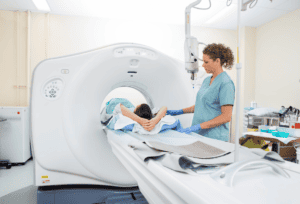
Understanding CT Scans
CT scans, or Computed Tomography scans, are non-invasive imaging procedures with radiation beneficial for detecting bone and tissue abnormalities. CT scans work by rotating an X-ray tube around you, capturing multiple images from different body angles. A computer then assembles these images, providing a comprehensive view of the inside of the body, specifically bones, chest, abdomen, and pelvis, allowing our radiologists to provide an accurate diagnosis.
Advantages vs Limitations of CT scans
Advantages of CT scans:
- Rapid imaging, suitable for emergency cases.
- Effective for visualizing bone fractures and chest and lung conditions.
- Often used in guiding surgical procedures.
Limitations of CT scans:
- Involves exposure to ionizing radiation.
- May not provide the same level of soft tissue detail as MRI.
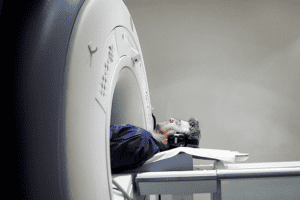
Understanding MRI Exams
Magnetic Resonance Imaging (MRI) is an exam that works by utilizing a powerful magnetic field to create highly detailed images of organs, soft tissues, bones, and other internal body structures. By using strong magnets and radio waves to produce clear images inside your body, hydrogen atoms align, capturing the signals they send when they return to their normal positions. MRIs capture intricate soft tissue details to detect conditions or diseases within areas like the brain, spinal cord, and joints. These precise images allow our radiologists to thoroughly evaluate and identify potential diseases that might not be easily detectable through other imaging methods.
Advantages vs Limitations of MRI exams
Advantages of MRI exams:
- Soft tissue visualization.
- No exposure to ionizing radiation.
- Excellent for a broad range of conditions and diseases, including heart disease, cancer and muscular and bone disorders.
Limitations of MRI exams:
- Slower imaging process compared to CT.
- May not be suitable if you have certain metal implants.
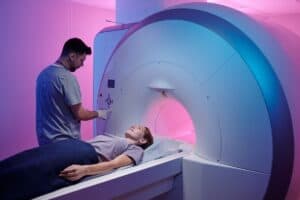
Differences between CT and MRI Scans
CT scans use X-rays, while MRI scans utilize strong magnetic fields and radio waves; this fundamental difference in technology results in distinct images. Both CT and MRI scans may use contrast agents to enhance image clarity. However, the types of contrast agents and how they are administered differ between the two exams. One significant difference is that CT scans expose you to ionizing radiation, which can be a concern for you. MRI scans do not involve radiation, making them a safer option in specific cases.
Factors Considered in Choosing Between CT and MRI Scans
Patient Factors Influencing the Choice of CT or MRI
Your age, medical history, and specific conditions are crucial in determining the appropriate imaging method. Additionally, considerations such as allergies and contrast agent compatibility are also important.
Diagnostic Considerations Influencing the Choice of CT or MRI
The choice between CT and MRI depends on the parts of the body or organs to be examined and the clarity required for visualizing specific structures.
Clinical Indications and Urgency of Diagnosis
In trauma and emergencies, the urgency of the diagnosis may influence the choice of imaging exam, leading healthcare professionals to choose a CT scan. For ongoing or chronic conditions requiring long-term monitoring, healthcare professionals lean towards an MRI.
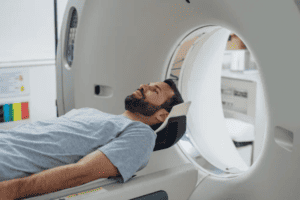
Comparison of MRI and CT Scans
Understanding the key differences is crucial when choosing between MRI (Magnetic Resonance Imaging) and CT (Computed Tomography) scans. Let’s dive into a side-by-side comparison to help you take in aspects of each one:
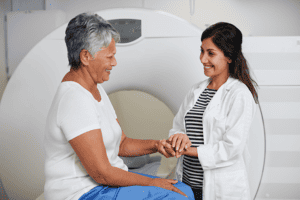
Imaging Technology and How They Differ
- MRI: Utilizes a powerful magnetic field and radio waves to create detailed images. It excels in capturing soft tissue details.
- CT: Relies on X-rays and a rotating X-ray tube to produce images, making it suited for visualizing bones.
The Kind of Images Each Exam Produces and Their Clarity/Detail
- MRI: Produces highly detailed images of organs, soft tissues, and internal structures, offering exceptional clarity and detail.
- CT: Provides clear images of bones, chest, abdomen, and pelvis, but may not match the level of detail achieved by MRI in soft tissues.
The Types of Medical Conditions Each Exam Is Better Suited For
- MRI: Ideal for assessing conditions related to soft tissues, such as brain and spinal cord issues, joint problems, and abdominal abnormalities. It’s especially effective for diagnosing cancer and muscular or bone disorders.
- CT: Well-suited for detecting bone fractures, lung conditions, and urgent medical cases where quick imaging is critical.
Duration and Your Experience During the Scan
- MRI: Scans may take longer due to their detailed images. Patients may need to lie still for an extended period, which can be challenging for some.
- CT: Known for its speed, CT scans often have quick exams, requiring less stillness as you lay on the table, resulting in a more comfortable experience.
Safety Considerations, Including Exposure to Radiation in CT Scans
- MRI: Does not involve radiation exposure, making it a safer choice.
- CT: Exposes patients to radiation, which can be a concern; however, the dose is typically low.
Understanding these differences between MRI and CT scans is vital in making an informed decision about your care. The choice ultimately depends on your specific medical needs, preferences, and the guidance of your healthcare provider. Whether it’s the clarity of an MRI or the speed of a CT scan, the goal is always the same – to provide you with the right treatment plan and the best possible care.
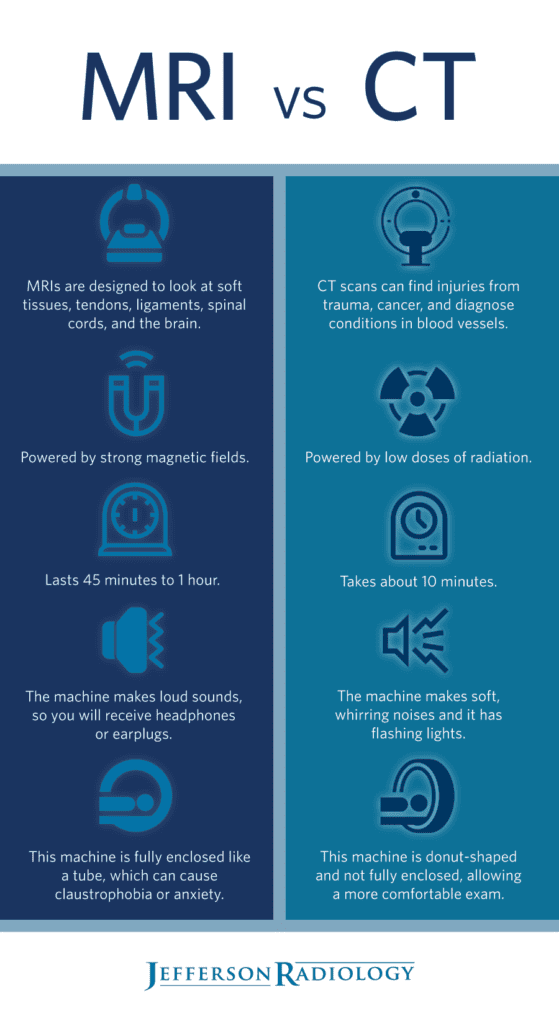
Case Examples: CT vs. MRI Scans
Examples Illustrating When CT Scans Are Preferred
- Trauma cases with suspected fractures.
- Rapid assessments such as lung conditions in the emergency department.
Examples Illustrating When MRI Exams Are Preferred
- Neurological assessments for conditions like multiple sclerosis.
- Evaluating soft tissue injuries in joints and ligaments.
Case Scenarios Where Both CT and MRIs May Be Utilized
- In complex cases, CT and MRI scans may provide a more comprehensive view of the area of concern, ensuring a precise diagnosis.
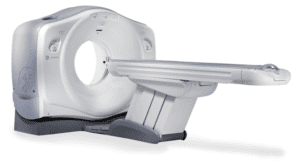
Collaboration between Radiologists and Referring Physicians
Our experienced radiologists and referring physicians collaborate closely to provide you with exceptional care. Through effective communication and joint decision-making, we tailor diagnostic exams to your unique needs. For advanced imaging, our fellowship-trained radiologists and dedicated staff work with referring providers to create seamless plans, ensuring your well-being.
Conclusion
In conclusion, understanding the differences between CT scans and MRI exams is vital for providing you with individualized care. Both imaging modalities offer unique advantages and limitations, and your specific needs should be considered when choosing the right exam. No matter the imaging exam, Jefferson Radiology is committed to delivering comprehensive state-of-the-art subspecialized radiology services paired with the highest quality care.
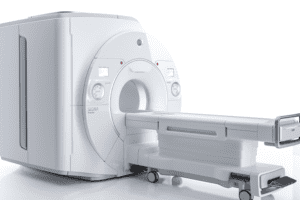
Resources
- The National Institute of Biomedical Imaging and Bioengineering (NIBIB) provides information on medical imaging technologies, including MRI and CT scans.
- Radiological Society of North America (RSNA): RSNA offers educational materials and resources related to medical imaging, including articles and guidelines
- American College of Radiology (ACR) provides guidelines, patient resources, and up-to-date information about radiological procedures, including MRI and CT scans.
- Mayo Clinic’s website offers extensive information about various medical conditions, diagnostic procedures, imaging techniques, and clinical trials for MRI and CT scans.








